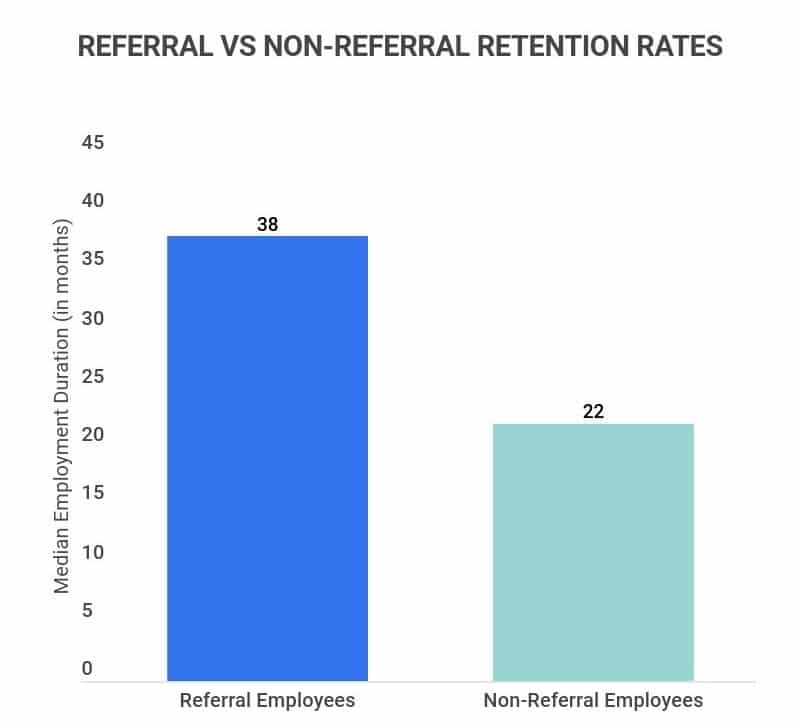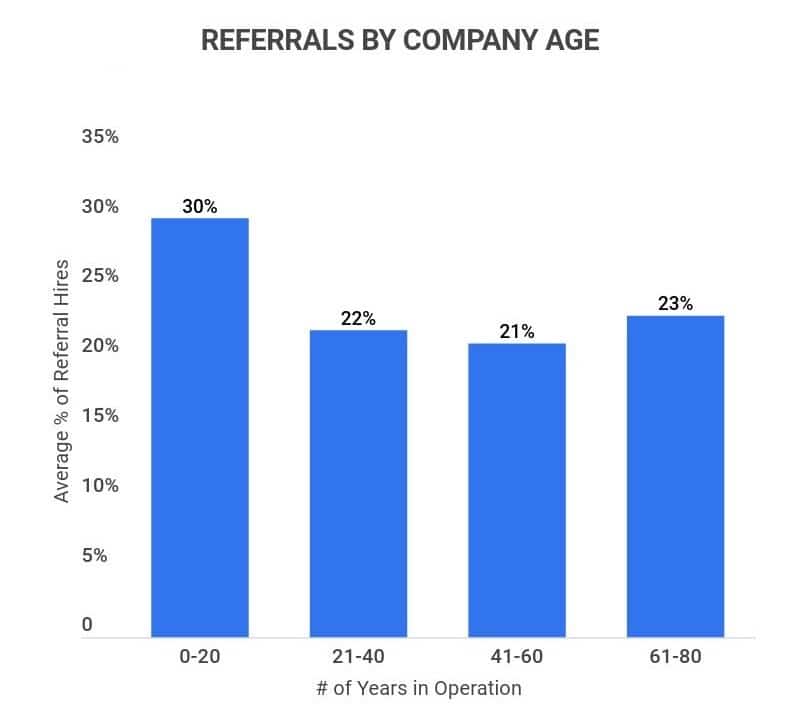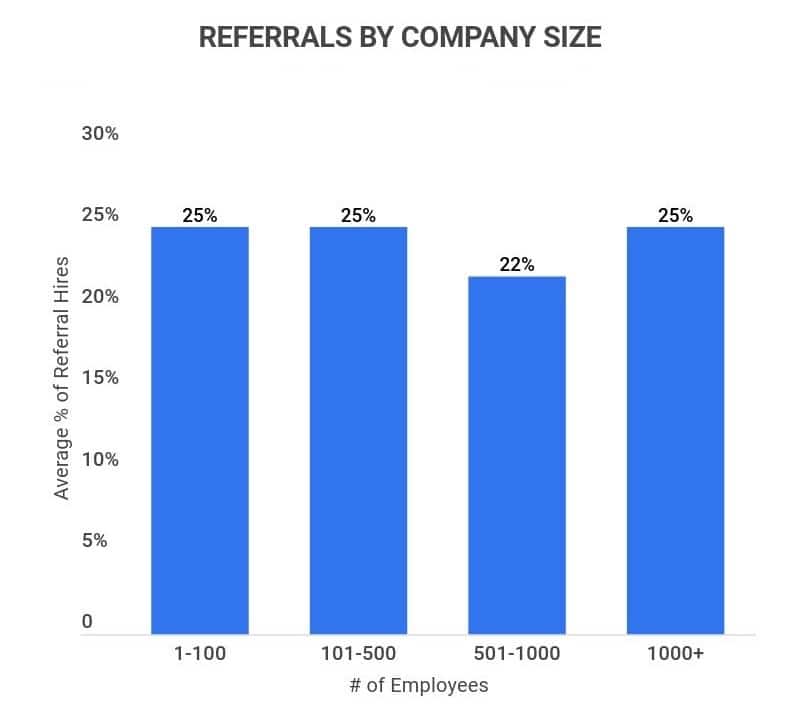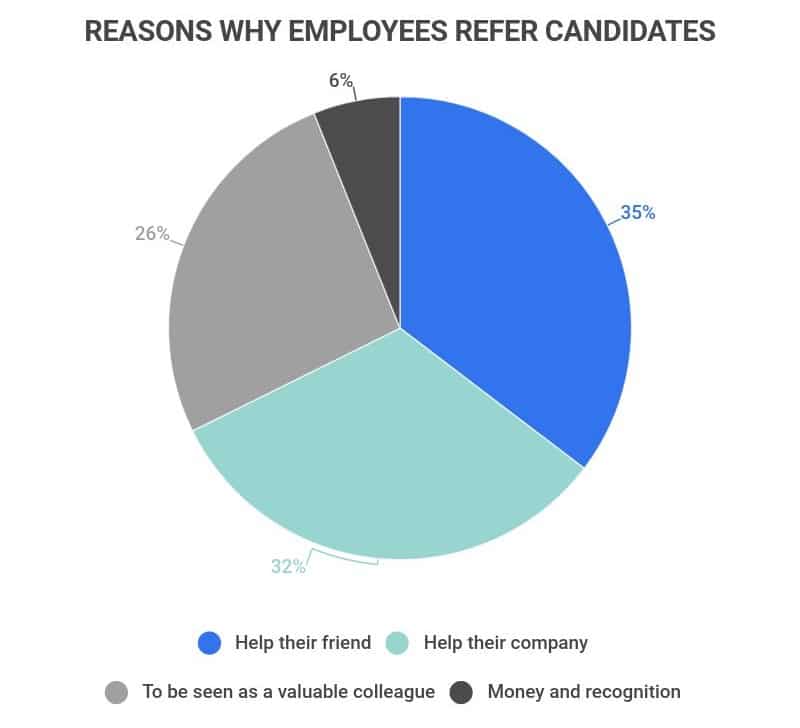- Workplace Statistics
- Time Management Statistics
- Employee Wellness Statistics
- Employment Discrimination Statistics
- Employee Recognition Statistics
- Employee Referral Statistics
- Workplace Violence Statistics
- Gamification Statistics
- Employee Feedback Statistics
- Agile Statistics
- Productivity Statistics
- Meeting Statistics
- Cell Phones At Work Statistics
- Social Media At Work Statistics
- Workplace Injury Statistics
- Workplace Stress Statistics
- Leadership Statistics
- Workplace Collaboration Statistics
- Job Satisfaction Statistics
- Paid Holiday Statistics
- Communication In The Workplace Statistics
- Wasting Time At Work Statistics
- 4-day Workweek Statistics
Research Summary. As job hunting evolves, so too does the importance of employee referrals. The fact is that employee referrals are far more likely to land hires compared to most other methods. After all, employers want highly qualified people they can trust, and referrals are a great way to find those people. Overall, our extensive research shows that:
-
Referrals are 4x more likely to be offered a job than website applicants.
-
45% of referral hires stay longer than four years, compared to only 25% of job board hires.
-
Employee referrals account for 30-50% of all hires.
-
The cost-per-hire of employee referrals is $1,000 less on average than other hiring sources.
-
88% of employers rate employee referral programs as the best source of applicants
-
Referred candidates are 2.6% to 6.6% more likely to accept job offers
For further analysis, we broke down the data in the following ways:
Performance | Frequency | Referral Programs

Employee Referral Statistics By Retention
High turnover is a huge waste of time, money, and resources for employers. For that reason, any frugal employer would want to hire as efficiently and inexpensively as possible. Here’s how referrals affect that process:
-
Using referrals increases retention by 40%.
On average, referral hires have a retention rate of 46%, compared to a 33% retention rate for workers found through an online job posting website. Increased retention leads to an average 41% reduction in expenses when hiring referrals, as hiring costs associated with backfilling the position are avoided.
-
Referred hires stay 70% longer than other employees.
The difference in how long employees stay between referral and non-referral hires is significant, with 50% of all referral employees staying in their position for at least three years. On the other hand, 50% of non-referral employees are gone just over a year and a half after being hired.
-
Hiring referrals reduces company turnover by up to 20%
Even when employers only hire 30% of their employees through referrals, their turnover rate is still reduced by 6%.

Employee Referral Statistics By Performance
Consistently hiring through employee referrals shows increased performance, not only for employees but also employers. This increased performance can save time, money, and resources. Overall, our research shows that:
-
88% of employers rate employee referrals as the best return on investment (ROI) for sourcing talent.
This can be for several reasons, including that they’ll likely save money through hiring and earn more money from the prospective employee. Plus, referral employees are more likely to have the skills employers are looking for.
And, if that’s not enough, hiring through referrals can make it easier for employers to avoid understaffing, as they’ll continue to have a pool of new referral candidates.
-
Referral employees are 25% more profitable.
That includes the cost-per-hire of employee referrals, which is $1,000 less on average than other hiring sources, and referrals have lower turnover rates and tend to perform their jobs more efficiently.
-
70% of businesses agree that referrals have the best culture fit for their company.
Workplace culture is more than just a buzzword, as it can mean the difference between a functional and dysfunctional environment. With that in mind, most employers find it much easier for referrals to match their company’s culture.
Employee Referral Statistics By Frequency
Given the effectiveness of employee referrals, you might not be surprised to learn about their increased frequency on the job market. Overall, employers rely more and more on referrals than job board sites and other sources. According to our research:
-
Up to 45% of internal hires are referrals.
That’s nearly half of all internal hires, meaning that if a company were to internally hire 500 new employees within a year, 225 of those employees would be the result of referrals. This is even more significant because only around 7% of all applicants are referrals.
-
Around 71% of employers have a referral program in the U.S.
More and more employers offer these programs and give bonuses and other incentives to employees who choose to participate. The company Dell, alone, has used its referral program to amass 40,000-50,000 referrals each year.
-
Referrals only make up 7% of total U.S. applicants, as of 2022.
This is an incredibly low number, given that an average of 30-50% of those hired are referrals. To dissect this, imagine that 200 people apply for a job with ten openings. Of those 200 people, only 14 would be referrals.
However, 4 out of those 14 would be hired, and only 5 out of the other 186 would be. Overall, referral employees had a 28.5% of being hired, while non-referral employees only had a 2.7% chance.
-
The consulting firm Booz Allen Hamilton has one of the most successful referral programs in the country, responsible for 55% of their hires.
Not only are referrals far more likely to be hired at this company, but their employees are also greatly rewarded for their efforts. The company pays its current employees up to $3,000 for participating and selecting a successful candidate.
-
Companies between 0-20 years of age are more likely to rely on referrals (nearly 30% of all hires).
That’s considerably more than companies that are 41-60 years of age, which only hire roughly 21% of their employees from referrals.
-
All companies, regardless of size, receive over 20% of their hires from referrals.
While companies with 500-1000 employees have the lowest rate of hiring referrals, at around 22%, all company sizes are surprisingly equal. Overall, whether a company has less than ten employees or over 1000, they all rely on referrals equally.
-
72% of interviews are referrals.
When applying, referrals stand a much higher chance of being asked to do an interview. While only 7% of applicants are referrals, they make up a whopping 72% of interviews. That means that if 300 people applied and only 30 were interviewed, all 21 of the referral applicants would be interviewed.


Employee Referral Statistics By Referral Programs
In the U.S., many companies offer their own referral programs. These programs bring in high-quality hires and reward the employees who refer them. With that in mind, here are some facts about referral programs:
-
Companies can have a talent pool that’s 10x bigger by gaining referrals through their employees’ networks.
In fact, most employees are also willing to do this free of compensation. The vast majority, 67%, will refer to help their friends or their company, while only 6% do it for money and recognition.
-
Only 4% of company referral programs successfully hire 30% of their employees through referrals.
Likely due to lack of employee incentives, only 4% of these programs successfully hire 30% of their employees through referrals. That means many companies have a long way to go if they want to make their referral programs successful.
-
The average employee referral bonus amount is $2,500.
However, bonuses can range anywhere between $1,000-$5,000, depending on a few factors. For example, an employee with a higher seniority level may earn a higher bonus than a newer employee.
-
35% of employees refer to help their friends.
Breaking it down further, only 32% do it to help their company, 26% do it to be seen as a valuable colleague, and only 6% do it for money and recognition.
-
69% of companies offer an amount between $1,000-$5,000 for an employee referral.
These payments are meant to encourage engagement, as the biggest hurdle facing successful referrals is getting employees to refer candidates.
-
The average employee referral takes 13+ days less to hire.
The average hiring process takes 42 days, but that process can be reduced to 29 days when employers have a referral. That’s a time savings of up to 31%.

Employee Referral Statistics FAQ
-
What percentage of hires are employee referrals?
Employee referrals are 30-50% of hires, as of 2022. Factors like the company’s size, age, and success of the company’s referral program all play a role in these percentages.
For example, companies under 20 years old receive 30% of their hires from referrals, while that number is as low as 21% for companies between 41-60 years old.
Overall though, employee referrals make up a considerable percentage of hires, given that only 7% of applications are referrals. That means that even if there are far fewer referral applicants, they’re almost guaranteed to land an interview or successfully be hired.
-
What is the average employee referral bonus amount?
The average employee referral bonus amount is $2,500. However, at most companies the amount paid can range anywhere from $1,000-$5,000. Either way, this amount can reflect a week or more of pay for many people, making it a worthwhile bonus.
-
How effective is an employee referral program?
Employee referral programs are very effective for finding quality employees and saving money. When programs successfully gain referrals, these referrals can save 13+ days of hiring time and over $1,000 in hiring costs.
Of course, the biggest hurdle is incentivizing employees. Only 6% of employees participate in referral programs for financial incentives, so offering large cash rewards isn’t the key to a successful program. Instead, creating a positive company culture that encourages employees to reach out to their friends may be more beneficial.
-
What percentage of companies have an employee referral program?
71% of U.S. companies have a referral program. However, only 4% of company referral programs successfully hire 30% of their employees through referrals.
This divide can be bridged by encouraging employees to reach out to their friends, as the largest percentage of employees (35%) refer for that reason.
-
Do referred employees stay longer?
Yes, referred employees stay 70% longer. On average, referral hires have a retention rate of 46%, compared to only 33% of job board hires. That’s a 40% increase in retention rates. In particular, though, small companies tend to see the best gains from their referral hires, as these hires stay 122% longer than their job board counterparts.
-
Do companies prefer referrals?
Yes, companies tend to prefer referrals. Companies prefer referrals for many reasons, but here are the most prominent ones:
-
Less time to hire. Employers save an average of 13 days when hiring a referral.
-
Cost less to hire. Employers save $1,000+ in hiring costs when they hire a referral.
-
Stay Longer. Referrals stay 70% on average. 45% of referral hires stay longer than four years, compared to only 25% of job board hires.
-
Better fit. 70% of businesses agree that referrals have the best culture fit for their company. Referrals tend to be familiar with the career they’re going into, or at least know some of their future co-workers. This makes it easy for them to fit into the company’s culture.
-
Conclusion
Without a doubt, referrals have become one of the most important and successful ways companies hire new employees. There’s a reason that despite making up only 7% of the hiring pool, 30-50% of those who land a job are referrals.
The fact is, referrals offer their employers many perks and benefits. From saving thousands of dollars in hiring costs to working at the company for 70% longer, employers gravitate toward the benefits of referral hiring.
The only thing left for employers to do now is improve their referral programs, as financial incentives seem to only slightly affect the process. Instead, providing a positive company culture and encouraging employees to network may be a more effective way of increasing referral numbers.
Sources
-
Undercover Recruiter. “Why Employee Referrals are the Best Source of Hire.” Accessed on March 13th, 2022.
-
Talentspotting. “How can employee referral help you cut recruitment costs?” Accessed on March 13th, 2022.
-
ICIMS. “How Employee Referrals Impact Retention.” Accessed on March 13th, 2022.
-
HRTechSeries. “How Employee Referrals Can Reduce Hourly Worker Turnover.” Accessed on March 13th, 2022.
-
CareerBuilder. “How Employee Referral Programs Turn Good Employees Into Great Recruiters and Grow Your Bottom Line.” Accessed on March 13th, 2022.
-
CareerBuilder. “2020 Employee Referral Programs Benchmark Report.” Accessed on March 13th, 2022.
-
BLR. “Fuel Your Employee Referral Program with a Marketer Mindset.” Accessed on March 13th, 2022.
-
TalentCulture. “How to Get More People to Use Your Employee Referral Program.” Accessed on March 13th, 2022.
-
Monster. “How to Create a Successful Employee Referral Program.” Accessed on March 13th, 2022.
-
SHRM. “Employee Referrals Remain Top Source for Hires.” Accessed on March 13th, 2022.
-
LinkedIn. “The Ultimate List of Hiring Statistics.” Accessed on March 14th, 2022.
-
Firstbird. “The future of employee referrals after COVID-19.” Accessed on March 14th, 2022.
- Workplace Statistics
- Time Management Statistics
- Employee Wellness Statistics
- Employment Discrimination Statistics
- Employee Recognition Statistics
- Employee Referral Statistics
- Workplace Violence Statistics
- Gamification Statistics
- Employee Feedback Statistics
- Agile Statistics
- Productivity Statistics
- Meeting Statistics
- Cell Phones At Work Statistics
- Social Media At Work Statistics
- Workplace Injury Statistics
- Workplace Stress Statistics
- Leadership Statistics
- Workplace Collaboration Statistics
- Job Satisfaction Statistics
- Paid Holiday Statistics
- Communication In The Workplace Statistics
- Wasting Time At Work Statistics
- 4-day Workweek Statistics






